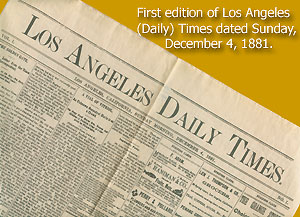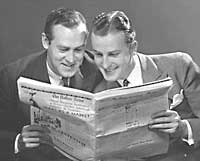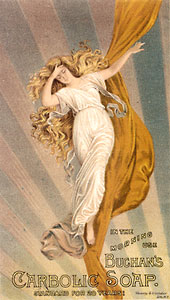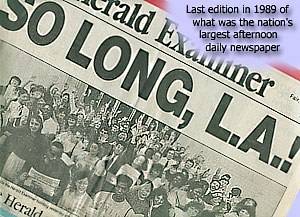The Print Media - 6 |
 Newspapers Historical
The Beginning of Mass By 1835, the United States was making newspaper history. Newspapers had freed themselves from government control, and there were more newspapers and newspaper readers than in any other country. It also helped that because of intense competition, the cost of some newspapers had come down to as low as one-cent a copy. Although this seems like a very low price, we have to remember that this was almost 170 years ago when everything was comparatively cheap. By this time advertisers had been attracted to newspapers, and young boys were hawking newspapers on street corners. Also at about this point in history the average citizen was reading two or more newspapers a day. This era, commonly called the era of "The Penny Press," is considered my many historians as the beginning of mass communication in the United States.
Many of the present-day newspapers got their start during this time, including The Chicago Tribune in 1847, and The New York Times in 1851. Among the newspapers to also appear in the mid-1800s were several that served minority interests. Most notable was Freedom's Journal, a black paper serving the interests of, in the worlds of the masthead, "the colored American." This was the first of more than 40 black newspapers to appear. When the Cherokee Indians were evicted from their home in Georgia, they started the Cherokee Advocate in their new settlement in Oklahoma. Another Cherokee publication to appear at about the same time was the Cherokee Phoenix, which was written in both Cherokee and English.
By 1848, the newspapers were trying to cover a wide range of events--even events in Europe. Newspaper couldn't afford to send reporters everywhere, so a system of sharing news was worked out. One reporter would cover an event and then share the story with other papers. This cooperative evolved into the Associated Press (AP), now the world's largest newsgathering organization. Associated Press Statistics
The U.S. Civil War (1861-1865) quickly stretched the boundaries of newsgathering. Before this time newsgathering had been a bit amateurish and disorganized. However, the public's intense interest in the progress of the war pushed journalism to new levels of efficiency. War reporting introduced the inverted pyramid style of writing news. Reports from the battlefield often had to be sent by telegraph, which Since a report could be interrupted before the transmission was complete, or it might have to be cut down because of financial and space considerations, reporters started the story with the most important developments and facts. These facts were expanded on as the story was developed. (Note illustration on the right.) Thus, the story could be cut without losing the most important facts. The inverted pyramid style has also become know as the who, what, when, why, and how approach to writing, where each of these questions is answered in the first sentence of the news story. Although this style has continued to this day for writing hard news in newspapers,
By this time, still film cameras had been invented, although a method of reproducing photos in print was a few years off. Instead, line drawings were made from battlefield photos. The effect was similar to what you see in many of the illustrations in today's Wall Street Journal. Matthew Brady was the most famous Civil War photographer. His photos brought the horrors of war home to readers. Military leaders on both sides took it on themselves to try to censor and limit battlefield news coverage. By the late 1800s, a halftone process for directly reproducing newspaper photographs from photographic prints had been invented. This introduced photojournalism and further spurred interest in newspapers. The history of photography is covered in a bit more detail in another module. The 1800s marked the beginning of many mainstream daily newspapers, including the Los Angeles Times, which published Volume 1, Number 1, on Sunday, December 4, 1888. The four-page paper featured about an equal number of columns of advertising and news. According to one ad, men's business suits were selling for $16 (marked down from $20).
As newspapers became more successful in the late 1800s and early 1900s, newspaper tycoons such as William Randolph Hearst and Joseph Pulitzer (of Pulitzer Prize fame) built empires. Although supposedly fiction, the film, Citizen Kane, which we discussed in another module, is widely believed to document Hearst's life--so much so that Hearst used his considerable influence to try to (somewhat unsuccessfully) get it banned. Competition between newspapers became intense and ushered in the era of yellow journalism. Although yellow journalism generally connotes an era of sensationalism, where crime, social scandals, and sex are used to sell papers, the term actually refers to a comic strip--one of the first to appear in any newspaper. The comic strip appeared in Pulitzer's New York World During this time, Hearst in particular blatantly used his papers to promote his own causes and to viciously attack his enemies. He was even accused of starting a war to sell newspapers by pushing for U.S. involvement in what turned out to be the Spanish-American War. Hearst sent a reporter to the front to cover the rumored war. When the reporter cabled back that there was no war in progress and that he was ready to come home, Hearst reportedly wired back, "Please remain. You supply the pictures, and I'll supply the war." After Hearst regularly published a steady stream of vitriolic editorializing against President William McKinley, the President was assassinated. Today, we don't have such vitriolic editorializing in our mainstream newspapers, but some The yellow journalism era was followed by the era of Jazz Journalism. This started in 1920, when Hearst and Pulitzer extended yellow journalism into tabloid journalism with an emphasis on sex, violence, murder, and celebrity affairs. Tabloid newspapers, which are still very much present today, are generally half the size of a normal newspaper, or about 11 by 14 inches. Popular ads of the day were for soaps (see photo on left), and various creams, ointments and tonics that would supposedly cure about anything. Papers such as the New York Daily News used screaming headlines, large photos, and short, punchy text to lure readers. It was a New York Daily News reporter that strapped a miniature camera to his leg and secretly took the notorious front-page picture of Ruth Snyder, as she was being electrocuted at Sing Sing prison in 1928. The original tabloids put a heavy emphasis on blood and gore. However, when supermarket sales became a major outlet, this was replaced by more acceptable fare: "tearjerker" stories, celebrity gossip, psychic tales, religious anecdotes, and various bizarre accounts.
After the era of jazz journalism (where the content of news and sensationalist fiction frequently overlapped), many people were ready for more accurate and responsible news reporting. A man by the name of Alolph Ochs believed that a newspaper didn't It was an idea that was long overdue, especially with middle and upper class readers. Some other New York papers followed, and the era of "responsible journalism" ensued. At the same time, Hearst and Pulitzer kept their focus on "the working class," and tended to stick the concepts of jazz journalism--concepts that are still "alive and well" in today's supermarket tabloids.
By the 1960s, radio and TV news had cut into the circulation of newspapers. Although most people turned first to the broadcast media for fast-breaking news, many relied on newspapers to fill in needed details--just as many people do today. (The text of a typical radio or TV newscast wouldn't even fill one page of an eight or nine column TV also changed readership patterns. Before TV, most people picked up their afternoon newspaper in the evenings after work. Now they turned on TV news at this time and preferred to read a morning newspaper over breakfast. Consequently, the afternoon newspapers, which had long been popular, lost favor. One of the causalities was the Los Angeles Herald Examiner. Once the nation's largest afternoon daily, the Herald Examiner ceased publication on November 2, 1989. By this time, the mainstream press had moved away from the excesses of yellow journalism and jazz journalism into an era of responsible journalism. The nation's larger newspapers--particularly The New York Times, the Washington Post, The Los Angeles Times, and the Wall Street Journal--enjoyed wide respect. The public at that time also had an almost unquestioned loyalty to the nation and its leaders. This unquestioned loyalty then took two major hits: the publication of the Pentagon Papers, and the Watergate scandal.
The Pentagon Papers were top-secret classified documents detailing the decisions and policies behind the U.S. involvement in the Vietnam War (1965-1973). First, a bit of background. During the Vietnam War between three and four million Vietnamese on both sides were killed, and more than 58,000 Americans lost their lives. For years this war saturated each night's TV news. The Pentagon Papers brought to light the political and military thinking behind the war--including some decisions and justifications that in retrospect are rather questionable. The government knew that bringing this information to light would undermine the public's confidence in their government--and, as it turned out, they were right. Before the war was over, a large percentage of Americans at home and serving in Vietnam had turned against the war. And since this module is about newspapers, we should mention that an estimated 250 underground antiwar newspapers were published by active-duty soldiers and distributed in coffeehouses. Opposition to the war started on college campuses and was fostered by campus newspapers. Since the general public was originally behind the war, a major "generational rift" resulted, with many young people being arrested and even in one case killed for protesting the war. Since most of them were engaged in legal demonstrations, most were released from jail within a short time--but the government's point had been made. However, as questions about the war continued to surface and the toll of dead and wounded mounted, antiwar sentiments finally spread to a significant percentage of the U.S. population. The U.S. news media, which originally had an almost unquestioned allegiance to the war effort, started reporting the major differences in what they were being told by the U.S. military and the Washington administration, and what they were finding out on their own. More accurate information was often being reported in the foreign media--things that, in order to try to maintain support for the war effort, U.S. officials were trying to keep from the American public. Feeling the public had a right to know what went on behind the scenes, The New York Times announced that they were going to publish the Pentagon Papers. Daniel Ellsberg, who helped write this exhaustive, top-secret study, had leaked the papers to the Times. His efforts to get these papers to the New York Times, and the government's efforts to find and stop him, represented a ongoing cat and mouse game for many weeks. Ellsberg was finally able to get the papers to a reporter, but he was subsequently arrested for treason, which could have carried the death penalty. Fortunately for him, the government had resorted to illegal and highly questionable activities to catch him, and when this came out during the trial, the judge through out the charges. Even so, the Nixon administration moved to block publication and successfully won temporary injunctions against the New York Times, and later, the Washington Post, which by this time had also planned to publish the papers. But, on June 30, 1971, the U.S. Supreme Court ruled that stopping publication amounted to “prior restraint,” which violated First Amendment protections. Both the New York Times and The Washington Post then published Pentagon Papers. While this was a victory for freedom of the press, the revelations undermined the public's confidence in the government and leadership. But, another major jolt was on the horizon.
Having learned from the Vietnam experience, the press now questioned the credibility of government briefings and press releases. In 1973, two reporters for the Washington Post faced down major threats and engaged in some tenacious investigative journalism to bring to light the corrupt dealings of U.S. President Richard M. Nixon. The story of the Watergate Scandal and reporters Carl Bernstein and Bob Woodward of the Washington Post is documented in the Academy Award-winning film, All the President's Men. (The film is well worth renting from you local video store for both its educational and dramatic values.) While the investigative journalism behind this story further bolstered the credibility of newspapers (not to mention inspiring a generation of investigative journalists), it further undermined public confidence in government. The general mistrust between the government and the press that emerged during these times continues to this day. Today, however, the government and the military put far more emphasis on managing news and forestalling the efforts of reporters to uncover stories that are not in their best interests. After the Sept. 11th, 2001, terrorist attacks on the East Coast of the United States the media demonstrated much greater support of the goals of the military and the U.S. government. Interestingly, during the wave of nationalism that followed the attacks, the press was criticized for suspending to some degree its "watchdog" function, and not questioning the administration's goals and procedures.
For at least two years following the 9-11 attacks, patriotism soared in the United States, and the public was highly supportive of the administration. FOX news, which was pro-administration, soared in popularity, even ahead of CNN, which had long been the leader in cable network news. The popularity of the FOX news channel did not extent to Internet news, however, where CNN had a clear lead. This may be explained by the fact that Internet demographics (age, education, socioeconomic level, etc.) are quite different than the general demographics for FOX broadcast news. By late 2003, another element emerged. The invasion of Iraq earlier that year had been tied to the 9-11 attacks and Iraq's efforts to build weapons of mass destruction. However, as facts emerged, both rationales for the invasion became questionable. It did not help that the vast majority of the countries of the world opposed the invasion and the leader of Britain, the main U.S. supporter in the war effort, came under pressure to resign. Thus, the press, which depends on popularity for profits, felt it safe once again to start to question administration's polices. While this was going on, the Republican controlled FCC (Federal Communications Commission, which governs broadcasting) issued a decision that would have made it possible for the large media companies, which now control the majority of large media outlets in the country, to acquire more control over the country's media.
Given this, there was a major outcry from the public and the smaller companies that felt economically threatened, and despite the Bush administration's pledge to veto any effort to reverse the FCC decision, the U.S. House of Representatives voted 400-21 to stop the proposed change in ownership rules. From the beginning the media giants were reluctant to report on the controversy, for fear that it would not be in their best interests. The one real except was the Nightline program, which runs at 11:30 p.m. on ABC. It had one program on the controversy, but that was only then after the networks had been widely criticized for ignoring the issue. In general, the media in general were reluctant to appear anti-administration on any issue, because the Bush administration was key to their efforts to acquire more media properties. Public suspicion about the U.S. media's bias toward big business and the Bush administration may help explain the increased popularity in the United States of foreign news sources, such as the BBC, CBC. Does the press go too far in trying to bring to light things that the public is better off not knowing, as well as unnecessarily hurting the public's perceptions of their government and its leaders? Many would say "yes," the press is too intrusive, and it often brings to light things that the public is better off not knowing. Furthermore, many people feel that governments need to keep things secret from their citizens. Other people feel that, except for such things as legitimate national security issues, secrecy is often used hide corruption and malfeasance, which, among other things, works against an informed electorate and the democratic process. What do you think? In the next module we'll look at world newspapers. |
|
To next module To
index © 1996 - 2005, All Rights Reserved.
|
 The modern beat system of news coverage, where a reporter regularly covers specific sources, such as the police station or city council, was also developed during this period.
The modern beat system of news coverage, where a reporter regularly covers specific sources, such as the police station or city council, was also developed during this period.


 newspaper and included a character called the Yellow Kid, printed in yellow ink. Thus, the term yellow journalism.
newspaper and included a character called the Yellow Kid, printed in yellow ink. Thus, the term yellow journalism. 
 have to resort to sensational crime, sex, and gore to sell papers. Ochs purchased the New York Times and told readers that his paper wouldn't "soil the breakfast cloth."
have to resort to sensational crime, sex, and gore to sell papers. Ochs purchased the New York Times and told readers that his paper wouldn't "soil the breakfast cloth."